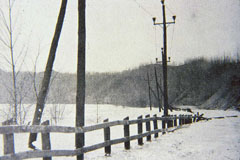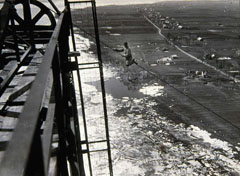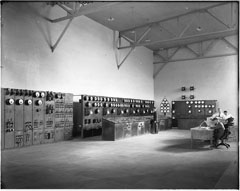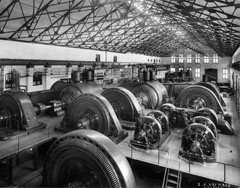Home > History > Shawinigan Water and Power > The Impact of SW&P on Hydroelectric Development Elsewhere in Canada
The Impact of SW&P on Hydroelectric Development Elsewhere in Canada
Shawinigan Water and Power (SW&P) was a dynamic and innovative company that expanded rapidly in the first decades of the 20th century. The company's business practices had an enormous impact on hydroelectric and industrial development in Quebec and Canada.
In 1899, SW&P built a modern hydroelectric plant to produce and distribute electricity. At the onset of the 20th century, the company participated in the planning and development in Shawinigan of one of the most important industrial complexes in Canada. Thanks to the promotional efforts of SW&P, the first aluminum smelter in Canada, a pulp and paper mill, a chemical products company and a textile plant were established in Shawinigan. Towards the middle of the 20th century, Shawinigan Chemicals, a subsidiary of SW&P, became one of the most important electrochemical centres in Canada.
In 1903, SW&P commissioned the longest transmission line in Canada, with a capacity of 50 000 volts running a distance of 135 kilometres towards Montréal. In 1904, the company built a second 50 000-volt transmission line linked to Montréal. Two years later, a line was installed under the St. Lawrence River at the height of Lanoraie to supply electricity to the cities of Sorel, Victoriaville and Thetford Mines. In 1919, in Trois-Rivières, the company installed a 1 927-metre-long line aerial line over the St. Lawrence River, a first in Canada.
In 1926, the company built a 165 000-volt line running 200 kilometres from the power plant of the Duke-Price Consortium of Île Maligne in the Saguenay to the City of Québec. In 1940, SW&P modified its production system from the 25-cycle current used by major industry to 60 cycles, which became the standard in commercial and domestic sectors. During the Second World War, the company built a 300 000-volt line between Trois-Rivières and Québec. Each of these innovations was to lead to myriad changes across Canada.
SW&P also stood out for the sheer size of its construction undertakings, in particular the Rapide-Blanc generating station on the Saint-Maurice River in the middle of a forest more than 200 kilometres north of Trois-Rivières. Not only did the company build a generating station, it also built a village. Construction began in 1930 and set the stage for future projects, serving as inspiration for endeavours such as Manic.
In 1919, SW&P founded Shawinigan Engineering, a firm responsible for designing and building new hydropower generating stations. Shawinigan Engineering would develop expertise acknowledged across Canada in the development of hydroelectric complexes. In 1954, the firm conducted a study of the hydroelectric potential of the powerful Churchill Falls in Labrador. In 1961, Shawinigan Engineering participated in the construction of the Churchill Falls complex. That same year, concern for diversifying its sources of electricity production led SW&P to begin construction of a thermal power plant in Tracy.
Thanks to the scope of their research and innovations, Shawinigan Water and Power and its subsidiaries invented new processes, several of which were patented and had a major impact on many companies across Canada. It is interesting to note that in 1987 Engineers Canada designated the Shawinigan-2 power plant built in 1910 by SW&P as one of the 25 great achievements in Canadian engineering over the past one hundred years.










